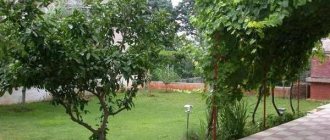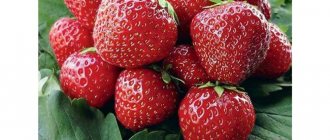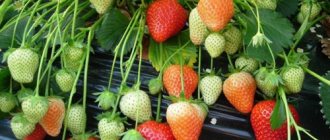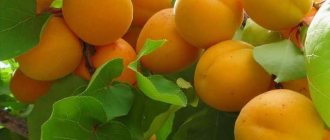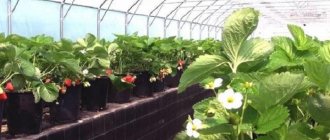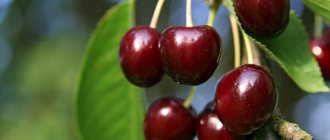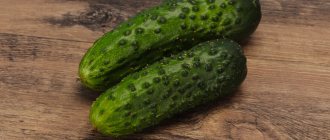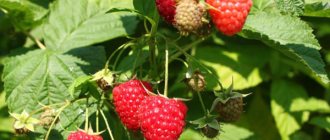Photo and description of the Ovstuzhenka cherry variety
The hybrid was bred at the Lupine Research Institute by the famous breeder M.V. Kanshina. Parent varieties are Leningradskaya Chernaya and Kompaktna Venyaminova. In 2001, information about the Ovstuzhenka cherry was included in the state register.
The tree has a spherical, dense, slightly raised shape. The branches are straight, of medium thickness, brown with a brown undertone. The buds are large, pointed. The leaves are elongated, with a rounded base and a pointed tip. The leaf blade is matte, flat, jagged along the edges. The petiole is short and has two glands. The buds are collected in inflorescences of 3 pieces. The flowers are large, the shape of the corolla is saucer-shaped, the petals overlap each other.
Description of the fruits of the Ovstuzhenka variety:
- average weight 4.2 g, maximum – 7 g;
- dimensions 16x19x19 mm;
- round shape;
- burgundy color;
- juice and pulp dark red;
- medium sized stalk.
The stone is round and brown with a pointed tip and easily comes away from the pulp. Sweet fruits have a marketable appearance. Taste properties are rated at 4.7 points. The Ovstuzhenka variety of cherries does not crack even in rainy weather. The separation from the stalk is dry. The purpose of the fruit is universal: consumption as a dessert and homemade preparations.
Mature tree height
Although the tree is fast growing, its size is quite compact. The height of the cherry tree is 2.5-3 m.
Flowering and ripening period
The Ovstuzhenka variety blooms in early May. Harvest ripening occurs in mid-June. Cherries begin to bear fruit in 4-5 years.
Productivity
Cherry variety Ovstuzhenka brings a high yield. On average, 16 kg of fruit is removed from a tree. Maximum yield – 30 kg.
Transportability
The fruits have good transportability and can withstand long transportation. The variety is suitable for growing for commercial purposes.
Drought resistance
Drought resistance is average. The formation of ovaries and productivity depend on the supply of moisture. Cherries are watered according to the usual scheme.
Frost resistance
The Ovstuzhenka variety has high resistance to frost. Trees tolerate temperatures as low as -31 °C. After a harsh winter, freezing is 0.3 points, and 34% of flower buds die. After spring frosts, about 20% of the pistils die.
Advantages and disadvantages
The variety has many advantages:
- High resistance to coccomycosis and moniliosis.
- Frost resistance.
- Early fruit ripening.
- Large size berries.
- Early fruiting - up to 30 kg per tree.
- Good safety during transportation.
- Compact size of trees.
Disadvantages include low self-pollination.
The Ovstuzhenka cherry is famous for its sweet large fruits
How to plant Ovstuzhenka cherries
Proper planting of the Ovstuzhenka variety is the key to a high yield. Carefully choose a place for its cultivation, prepare the seedling and soil.
How to choose a seedling
High-quality seedlings of the Ovstuzhenka variety are sold by nurseries and garden centers. Before purchasing, evaluate the quality of cherries. Choose the best annual trees 0.8-1 m high with a pronounced conductor and 2-3 shoots. Plants should not have rotten areas, mold, cracks, diseased branches or other defects. Sometimes the roots of a seedling are overdried. Then they are immersed in water for 3-4 hours. Before planting, remove all leaves.
Planting dates and scheme
The time for planting the Ovstuzhenka variety is chosen taking into account weather conditions. If winter comes early in a region, then work is planned for the spring. Wait until the soil warms up until the buds begin to swell. In the south, the crop is planted in the fall after leaf fall, a month before the cold snap, so that the seedling has time to take root.
A separate area is prepared for the Ovstuzhenka variety of cherries, away from apple, pear, plum and other fruit trees. Be sure to choose a sunny place, protected from the wind by buildings or fences. The culture prefers light, fertile soil: sandy loam or loamy soil. Close proximity to groundwater is not allowed.
Pit preparation
The planting pit begins to be prepared a month before the work. During this period, soil shrinkage will occur, which can damage the seedling. If planting takes place in the spring, you need to dig a hole in the fall. They also improve the composition of the soil. Coarse river sand is added to heavy clay soil, and a little clay and peat is added to sandy soil.
Algorithm for planting Ovstuzhenka cherries:
- A hole with a diameter of 60 cm and a depth of 70 cm is dug in the area.
- To fill it, prepare a substrate consisting of fertile soil and humus. From fertilizers, add 60 g of superphosphate and potassium salt. Minerals can be replaced with wood ash in an amount of 0.4 kg.
- The soil mixture is poured into the hole and left to shrink.
- When the time comes to plant cherries, form a small hill of soil.
- A plant is placed on top, its roots are straightened and sprinkled with soil.
- The soil is compacted and watered with warm water.
Landing Features
It is recommended to plant cherries in the northern regions in the spring, and in warm regions you can plant trees in the fall. Planting is carried out in dry and windless seasons. Seedlings are chosen mainly in specialized nurseries and stores.
Choosing a seedling and place for planting
Indicators of a healthy seedling:
- a large number of young shoots;
- clear vaccination site;
- smooth bark without spots and wrinkles;
- well developed roots without dried fragments.
A healthy cherry seedling has smooth bark without cracks or wounds, elastic shoots, and a clear grafting site.
The roots of the seedling should look powerful and light beige when cut. Zoned 2-year-old trees take root faster and easier than their younger brothers and more easily tolerate changing conditions and frosts.
It is advisable to plant Ovstuzhenka in the southern part of the garden, where sunlight can easily penetrate. The soil should be light and breathable.
Cherries (with good care) grow well both on loam and sandy soils.
The groundwater level in the cherry orchard should not exceed 1.5 m, otherwise a drainage ditch will be needed to drain the water.
Soil preparation
For spring planting, the soil is prepared in the fall. In a hole with a diameter and depth of 1 m, put 3 buckets of fresh mullein or humus, 2 tbsp. l. potassium sulfate, 1 tbsp. superphosphate and 2 tbsp. ash. All this is mixed with turf soil just before planting the seedling.
When a garden plot is being prepared, plantation plowing is carried out and during this process mineral and organic fertilizers are poured into the soil. Per 1 m2 of land it is necessary to add 10 kg of humus, 1 tbsp. superphosphate and 100 g of potassium fertilizer.
If you use ready-made fertilizer in the form of a multicomplex for soil, then 200 g of the substance per 1 m2 will be sufficient.
Spring preparation of planting holes occurs a couple of weeks before the actual planting of seedlings. To do this, the pits are filled one-third with a mixture of turf soil (2 buckets), superphosphate (3 kg), ash (1 kg), potassium (1 kg) and rotted manure or humus (about 30 kg). Adding nitrogen-containing substances is not required, as they can burn the roots.
Caring for Ovstuzhenka cherries
Cherries are provided with comprehensive care. The Ovstuzhenka variety needs watering, the supply of nutrients and crown pruning.
Feeding and watering
In the first two years after planting, the Ovstuzhenka variety needs enough fertilizer applied to the pit. In the future, the tree is fed annually. In early spring, it is watered with mullein infusion. Instead of natural fertilizer, use a urea solution (40 g per 10-liter bucket of water). During flowering and fruit formation, nitrogen fertilizing is completely excluded. Add 40 g of superphosphate or potassium salt to the soil. Every 3 years, the soil under the cherry tree is dug up and fertilized with compost.
The Ovstuzhena variety is watered according to the following scheme: during flowering, fruit ripening and in late autumn before sheltering for the winter. For seedlings under 5 years old, 6 buckets of water are poured; an adult tree requires up to 15 buckets. During drought, cherries need more moisture. It is applied in the morning or evening, when there is no direct sunlight.
Weeding and loosening
Weeds are regularly weeded in the tree trunk circle. After watering or precipitation, the soil is loosened to saturate it with oxygen. As a result, the roots of the tree quickly absorb moisture and beneficial elements from the soil.
Crown formation
For cherries, crown formation takes 5-6 years. During this time, 4 tiers are obtained, consisting of strong, healthy shoots. Dry, broken, old and improperly growing branches are cut out annually. Leave 0.5 m between tiers. Cherries are pruned in autumn or spring, when there is no active sap flow. The cut areas are treated with garden varnish. You can learn about growing Ovstuzhenka cherries and other varieties from the video:
Pollinators of the Ovstuzhenka cherry
The Ovstuzhenka variety is self-sterile. In the absence of pollinators, only 5% of fruits are set. Therefore, to obtain a high yield, be sure to plant other varieties that bloom early. A distance of 2.5-3 m is maintained between the trees. If there is no free space for cherries on the site, then several different varieties can be grafted onto one tree.
The best pollinators for Ovstuzhenka cherries:
- Here we go. A productive early ripening variety. Fruiting is stable and begins at 4-5 years. Flower buds have high winter hardiness. Sweet cherries are slightly susceptible to fungal diseases.
- Bryansk pink. The variety bears dense pink fruits that do not crack and tolerate transportation well. The pulp is yellow, the taste is sweet and sour. A winter-hardy tree of moderate growth rarely gets sick.
- Raditsa. The fruits are dark red, almost black, the taste is sweet. Cherries do not crack and are stored for a long time. Fruiting begins in the 4th year. Resistance to diseases is high.
- Red hill. A weak-growing tree with average resistance to frost and coccomycosis. The fruits are yellow with a pinkish blush.
Collection and storage of fruits
The fruits ripen in the first half of June. You can get 15–30 kg of berries from a tree. Cherries removed from the stalk are better preserved and tolerate transportation well. The fruits do not spoil in the refrigerator within a week. The berries are consumed fresh, juice, puree, jelly, and jam are prepared from them. You can freeze cherries and cook compotes from them in winter, add them to cottage cheese and desserts. Washed and dried berries without a stalk are laid out in one layer on a plate and placed in the freezer. Once hardened, they are placed in a bag and stored in the freezer.
Cherries contain a natural multivitamin complex. Of the 25 vitamins needed by humans, 10 were found in it. The berry is used for vitamin deficiencies, as a tonic and pain reliever, and is recommended for people with anemia and hypertension. The juice is useful for stomach pain, and a decoction of the stalks regulates cardiac activity. Sweet cherries do not contain acid like cherries, so children really like them.
You can harvest up to 30 kg of cherries from one tree
Diseases and pests of Ovstuzhenka cherries
The Ovstuzhenka variety is slightly susceptible to the fungal diseases moniliosis and coccomycosis. Additional treatment is required for clasterosporiasis. It is identified by brown spots on leaves, buds and shoots. Gradually, holes form in the leaf plate. To combat clasterosporiasis, the affected parts are cut off and the wounds are disinfected with a solution of copper sulfate.
Advice! Chemicals are not used for cherry fruiting.
Cherries are susceptible to attack by aphids, moths, leaf rollers, cherry flies and other pests. To get rid of insects, insecticides Iskra or Karbofos are used. When the fruits ripen, they turn to folk remedies: infusions of onion peels, wood ash, tobacco dust.
Characteristics of the variety
Cherry Ovstuzhenka: photo of the variety
The main characteristic of the Ovstuzhenka cherry variety is considered to be versatility. Quite tasty and healthy fruits with tonic characteristics can be consumed both fresh, unprocessed, and processed for storage. This variety is also very popular among farmers due to its resistance to cold, due to which the subspecies is grown in various weather conditions. This plant is often grown in private gardens due to its unpretentiousness and excellent early harvest.
As practice has shown, the Ovstuzhenka cherry variety is able to withstand frosts down to -45 degrees, therefore, as mentioned above, this tree is cultivated in absolutely all regions of Russia. Speaking of the dry period, this crop requires timely watering procedures. A tree of this variety is considered a rather moisture-loving crop. During watering, one such tree should require approximately 20 liters of water.
The flowering period of this plant begins in the second half of May. The tree is covered with inflorescences consisting of three large, white flowers. A distinctive feature of this subspecies of cherries is the high resistance to cold of vegetative and flower buds. At the moment when the berries of this tree acquire a dark shade, the onset of ripeness and harvest comes. Typically, fruit ripening occurs in the last week of June, and in the southern regions the berries are fully ripened by mid-June, while the Trans-Ural regions begin to harvest one month later. Pollinators of the Ovstuzhenka cherry are simultaneously flowering subspecies.
The Ovstuzhenka cherry forms a huge number of ovaries after the flowering period, if other subspecies of this crop grow near it. In this case, from one such plant you can collect up to 32 kilograms of ripe fruits, which, in turn, is considered a high indicator. Such scientific tests were carried out, after which the yield from one hectare of such plants was up to 206 centners per year. To ensure good preservation of the berries, they need to be picked when harvesting along with the stalk. Otherwise, the beneficial composition of substances threatens to be lost. The fruits are not prone to cracking, so they can be easily transported over long distances. It is worth noting that at an air temperature of more than 6 degrees and a humidity of more than 80 percent, the fruits of this variety retain their freshness during storage.
Cherries are considered to be quite a healthy berry. The fruits of Ovstuzhenka cherries can strengthen blood vessels and the heart. Their chemical composition contains the entire spectrum of multivitamins, which is considered sufficient to compensate for deficiency during vitamin deficiency. Such fruits are eaten fresh, although various compotes, desserts and jams from these berries also turn out excellent. The fruits of this subspecies can be frozen.
In order to avoid infection of this plant with fungal diseases, the tree trunk should be sprayed and treated with whitewash for preventive purposes. It is worth mentioning such an important fact as the presence of immunity in this variety to such common and dangerous diseases as moniliosis and coccomycosis, which, in turn, is very attractive to gardeners. You should also take preventive measures against insect pests. Although this tree should be provided with very good protection from rodent attacks and cold winds.
Like any other cherry variety, Ovstuzhenka has its advantages and disadvantages. The advantages of this culture include:
- A high level of frost tolerance, thanks to which the variety can grow in any region of Russia.
- The tree is small in size, making it simple and easy to care for and harvest.
- The fruits are large in size and have excellent taste characteristics.
- Immunity to fungal diseases.
- Early ripening.
- High level of productivity.
The disadvantages of the Ovstuzhenka cherry variety include the following:
- Low self-pollination rate, about 10 percent.
- Low level of cold resistance of plant stems.
Description of culture
The tree gains growth, spreading in height, for the first five years. After this period, fruiting begins. As a result, the height of the Ovstuzhenka cherry tree is not very large. It has a thick spherical crown, which is convenient for collecting fruits and caring for them. The leaf is ovoid, pointed, with teeth, and has a short petiole. Ripe berries are almost black, weighing up to 7 grams. Have the following characteristics:
- round or oval shape, large size;
- dark burgundy color;
- juiciness, medium density, easily separated from the stone;
- taste – 4.5 points (on a 5-point scale), sweet;
- dry matter – up to 17.7%;
- sugar – 11.6%;
- ascorbic acid – 13.4 mg per 100 g.
The variety grows even in the harsh conditions of Siberia. The winter hardiness of the Ovstuzhenka cherry is very significant. But it was developed for the Central region, including Bryansk, Ivanovo, Moscow, Kaluga, Tula, and Smolensk regions. Tolerating slight frosts well, Ovstuzhenka must nevertheless be protected from northern winds and be in the sun.
Features of growing this variety, depending on the region
The variety was developed specifically for the Central region; it can be grown in the Middle Zone and the Urals . In colder areas with short summers and long frosts, it will be more difficult for the plant to produce crops and accumulate strength for wintering. To prevent flowering plants from being exposed to short-term frosts, they are fumigated with smoke.
Care in Siberia, the Urals and the Far East should provide the plant with nutrients as much as possible. It is recommended to grow cherries on a dwarf rootstock, protect the branches from cold winds and promptly prune frozen branches so that they do not expose the tree to infection.
Ovstuzhenka is an early ripening variety, so there is a risk of fruit buds freezing during flowering . To prevent this from happening, they use the method of delaying the growing season. To do this, mulch the tree trunk circle after the first snow falls. In the middle of winter, the snow that falls is compacted. When it melts, the snow under the mulch will still keep the ground frozen, which will delay flowering for 2-3 weeks.
Important. The Central Black Earth region and Central Russia have favorable conditions for growing Ovstuzhenka, and therefore do not require additional measures.
Reviews from summer residents
Reviews from summer residents from different regions of Russia are mostly positive:
Alla, Tver : “We have been growing Ovstuzhenka at our dacha for five years now. The berries are not too large, but quite sweet. The first harvest was received last year. The variety is unpretentious, but requires frequent watering.”
Valentina, Voronezh : “The whole family loves to harvest cherries. Both children and grandchildren like berries. The tree overwinters well. We do not carry out special procedures for insulation. Growing since 2010.”
Ivan, Moscow : “Despite the frosty winters, the tree produces three buckets of berries per season. Of course, birds steal a lot, but the variety is productive and there is enough for everyone.”

